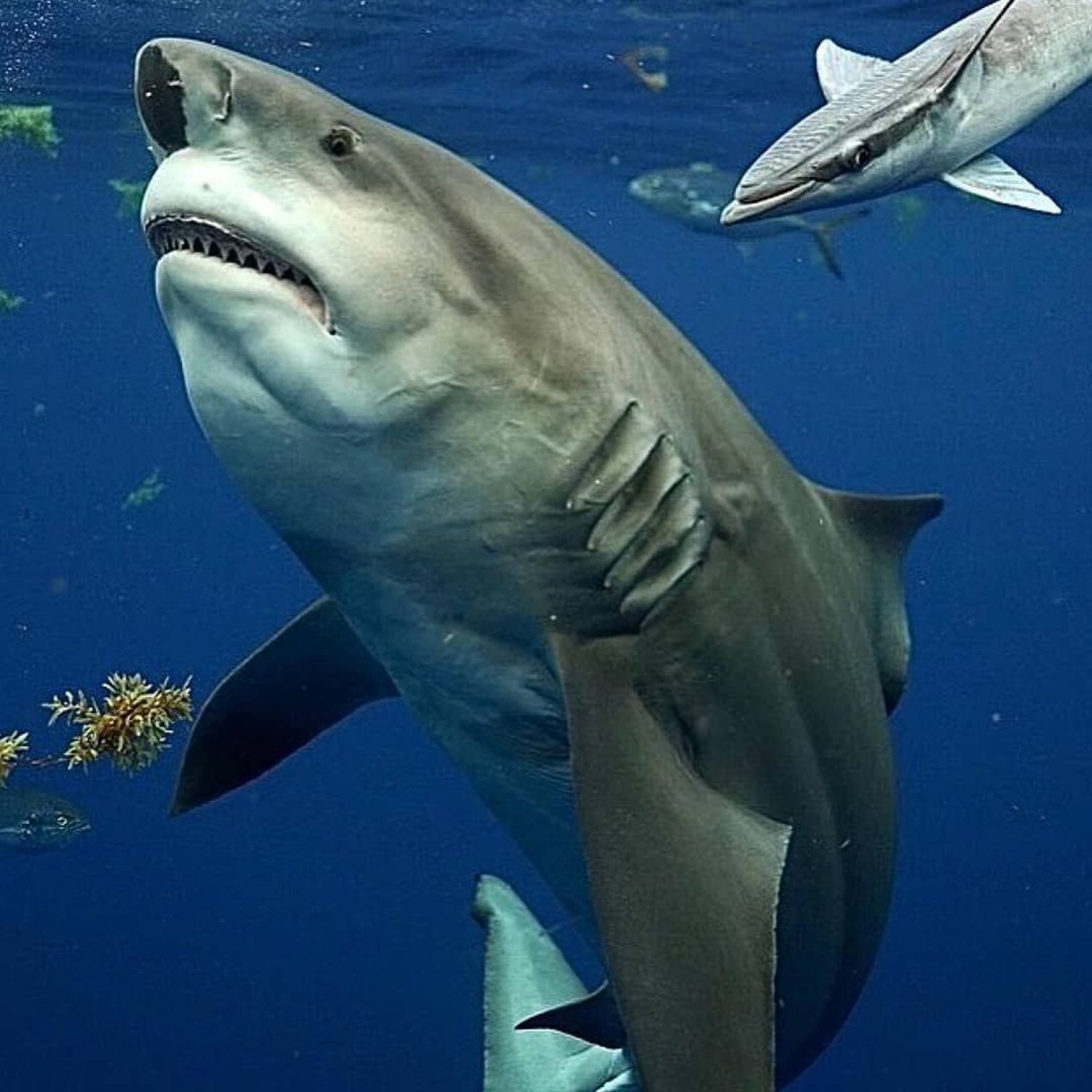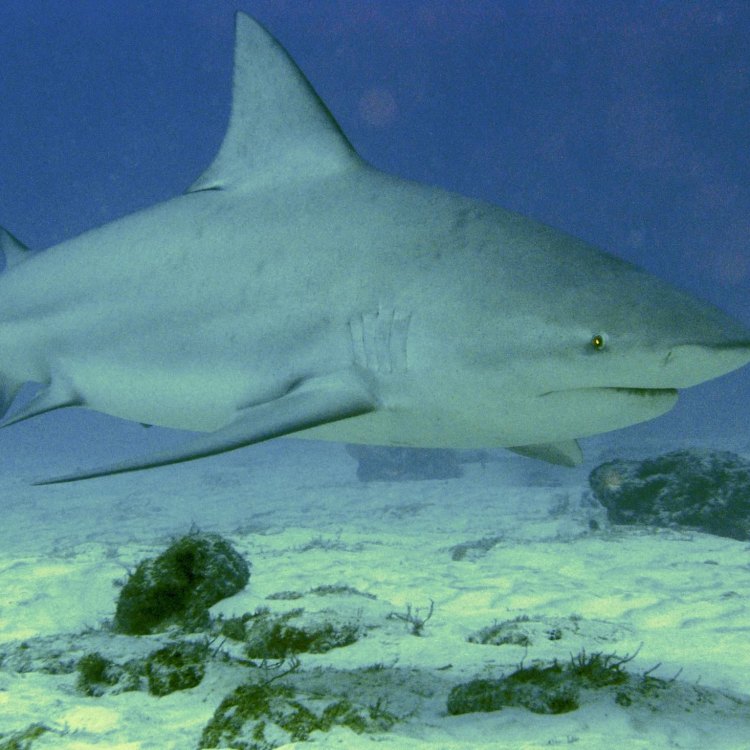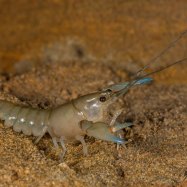
Bull Shark
7 to 11 feet (2.1 to 3.4 meters)
The Bull Shark, scientifically known as Carcharhinus leucas, is a feared predator found in both oceans and rivers. With a stocky and muscular body, it can grow up to 7 to 11 feet in length. Belonging to the Carcharhinidae family, this animal is commonly found in various oceanic and freshwater regions. Its aggressive nature and ability to adapt to different environments make it a top contender in the animal kingdom.
Animal Details Summary:
Common Name: Bull Shark
Kingdom: Animalia
Habitat: Coastal and freshwater areas
The Mighty Bull Shark: A Fierce Predator of the Seas and Rivers
When we think of sharks, we often picture the infamous great white shark or the majestic hammerhead. But there is one shark that is often overlooked, yet it is one of the most fascinating and adaptable species in the ocean – the Bull shark. With its impressive size, fierce nature, and unique abilities, the Bull shark has carved a distinct niche for itself in the underwater world. Let's dive deeper into the world of the Bull shark and discover what makes this creature so intriguing Bull Shark.A Brief Introduction to the Bull Shark
Scientifically known as Carcharhinus leucas, the Bull shark gets its name from its bulky and muscular body, resembling that of a bull. It is a member of the Carcharhiniformes order and belongs to the Carcharhinidae family, which includes more than 50 shark species. The Bull shark is commonly found in coastal and freshwater areas and is known for its aggressive and territorial behavior. This remarkable species is widely distributed in tropical and subtropical waters around the world.Adaptations for Survival
As one of the most successful predators in the ocean, the Bull shark has evolved to possess several unique adaptations that aid its survival in diverse environments. Unlike other sharks that can only survive in saltwater, the Bull shark has the unique ability to thrive in both freshwater and saltwater, making it a truly adaptable species. This is possible due to a specialized gland in its kidneys that can adjust the salt concentration in its body, allowing it to regulate its freshwater and saltwater intake.Another fascinating adaptation of the Bull shark is its ability to navigate in shallow and murky waters with ease. Unlike other sharks that rely on their highly sensitive vision to hunt, the Bull shark has a unique sensory adaptation known as the Ampullae of Lorenzini Black Crappie. These special organs, located in its snout, can detect even the slightest movement and electrical signals emitted by its prey, making it an efficient hunter even in low visibility conditions.
The Bull Shark's Habitat
The Bull shark is a truly versatile predator, inhabiting both the oceanic and freshwater regions. It can be found in various bodies of water such as rivers, estuaries, and mangrove swamps. In fact, this shark is known for its ability to swim hundreds of miles upstream into rivers and even cross continental divides. This unique adaptation allows them to hunt for prey in diverse environments and gives them a competitive advantage over other shark species.Feeding Behavior
As a carnivorous species, the Bull shark has a varied diet, feeding on a wide range of prey including fish, dolphins, turtles, and even other sharks. Its sharp serrated teeth are capable of slicing through tough prey with ease. Its powerful jaws and muscular body allow it to take down its prey with a single bite, making it a formidable predator in the underwater world. Due to its territorial nature, the Bull shark often hunts in shallow waters, attacking its prey from below with a surprise attack.The Bull Shark's Appearance and Physical Characteristics
The Bull shark has a distinct coloration with a gray to brown upper body and a white underbelly. This coloration allows it to blend in with the ocean floor and ambush its prey without being detected. It has a stocky and muscular body that can grow up to 11 feet (3.4 meters) in length, making it one of the larger species of sharks. Its massive size and powerful body make it an intimidating predator to its prey.Threats and Conservation Status
Unfortunately, the Bull shark faces numerous threats in the wild, primarily due to overfishing, habitat destruction, and pollution. Its fins are highly sought after for the shark fin trade, and its meat is also consumed in many parts of the world. Additionally, the Bull shark often gets caught in fishing nets meant for other species, resulting in accidental bycatch. These combined factors have led to a significant decline in their population, making the Bull shark a vulnerable species according to the IUCN Red List.How You Can Help
As with any other species, raising awareness and making small changes in our daily lives can go a long way in preserving the Bull shark and its ecosystem. Supporting sustainable fishing practices and reducing single-use plastics can help reduce the impact on their habitat. Additionally, educating others about the importance of conservation can help create a more sustainable future for these magnificent creatures.Discovering the Bull Shark
One of the best ways to learn more about the Bull shark and its behavior is through diving and snorkeling experiences. There are many dive sites around the world where you can encounter these magnificent creatures in their natural habitat. However, it is essential to do your research and choose an eco-friendly and responsible tour operator that prioritizes the well-being of the animals and their environment.In Conclusion
In conclusion, the Bull shark is a truly remarkable species that deserves our attention and conservation efforts. Its ability to thrive in diverse environments, powerful hunting skills, and unique adaptations make it a fascinating predator in the underwater world. By understanding and appreciating these magnificent creatures, we can work towards creating a sustainable future for the Bull shark and all other species that call the ocean their home.

Bull Shark
Animal Details Bull Shark - Scientific Name: Carcharhinus leucas
- Category: Animals B
- Scientific Name: Carcharhinus leucas
- Common Name: Bull Shark
- Kingdom: Animalia
- Phylum: Chordata
- Class: Chondrichthyes
- Order: Carcharhiniformes
- Family: Carcharhinidae
- Habitat: Coastal and freshwater areas
- Feeding Method: Carnivorous
- Geographical Distribution: Tropical and subtropical waters
- Country of Origin: Worldwide
- Location: Various oceanic and freshwater regions
- Animal Coloration: Gray to brown on top, white on the bottom
- Body Shape: Stocky and muscular
- Length: 7 to 11 feet (2.1 to 3.4 meters)

Bull Shark
- Adult Size: Up to 11 feet (3.4 meters)
- Average Lifespan: 16 years
- Reproduction: Viviparous
- Reproductive Behavior: Internal fertilization
- Sound or Call: Not known to make sounds
- Migration Pattern: Coastal migrations
- Social Groups: Solitary or in loose groups
- Behavior: Aggressive and territorial
- Threats: Habitat destruction and overfishing
- Conservation Status: Near Threatened
- Impact on Ecosystem: Top predator in its habitat, maintaining the balance of ecosystems
- Human Use: Commercial and recreational fishing, tourism
- Distinctive Features: Powerful jaws, short snout, broad and rounded body
- Interesting Facts: Capable of surviving in both saltwater and freshwater environments
- Predator: Large sharks and humans

Carcharhinus leucas
Bull Shark: The Ultimate Survivor of Ocean and Freshwater
The ocean is a vast and mysterious world, filled with creatures that continually amaze and educate us. Among these creatures is one of the most fascinating and unique sharks, the bull shark. With their powerful jaws, unpredictable behavior, and ability to survive in both saltwater and freshwater environments, the bull shark is a top predator that plays a crucial role in maintaining the balance of ecosystems.In this article, we will dive deep into the world of bull sharks, exploring their distinctive features, behaviors, threats, and impact on the ecosystem PeaceOfAnimals.Com. We will also uncover some interesting facts about this impressive species and its relationship with humans. By the end, you'll have a newfound appreciation for these often misunderstood creatures.
Adult Size and Average Lifespan
First and foremost, let's talk about the size and lifespan of bull sharks. As the name suggests, these sharks are known for their bulky and muscular body structure. On average, they can grow up to 11 feet (3.4 meters) in length, making them one of the largest known species of shark. However, some individuals have been recorded to reach lengths of up to 13 feet (4 meters), making them one of the most powerful and robust shark species.
In terms of lifespan, bull sharks can live up to 16 years in the wild. However, this can vary depending on the availability of food and other environmental factors Banana Eel. In captivity, they can live up to 25 years, but this is a rare occurrence as bull sharks are not commonly kept in aquariums due to their aggressive nature.
Reproduction and Reproductive Behavior
Like many shark species, bull sharks are viviparous, which means they give birth to live young. This is a unique reproductive trait as most fish species lay eggs. However, what makes bull sharks even more remarkable is their reproductive behavior, which involves internal fertilization. This means that male bull sharks use their claspers (modified pelvic fins) to transfer sperm directly into the female's reproductive tract. This process not only ensures a higher chance of successful fertilization but also reduces the chances of predation on the fertilized eggs.
Sound or Call
Bull sharks are not known to make sounds or calls like some other shark species. They rely on their impressive senses, including hearing, vision, and electroreception, to navigate and communicate with other sharks. This is crucial for their survival, as they need to constantly be aware of their surroundings and any potential threats.
Migration Pattern and Social Groups
One of the most intriguing aspects of bull shark behavior is their migration patterns and social groups. While they are capable of long-distance movements, bull sharks are predominantly coastal migrators. They can be found in tropical and temperate waters all around the world, from the Gulf of Mexico to the coast of Australia. Although they are solitary creatures, bull sharks have been known to form loose groups when food is abundant or during mating season.
Behavior: Aggressive and Territorial
Bull sharks are known for their aggressive and territorial behavior. Unlike most shark species, they are known to be more unpredictable and prone to attacking without provocation. This can be attributed to their territorial nature and their ability to thrive in both saltwater and freshwater environments. Bull sharks are highly adaptable and are not afraid to explore new territories in search of prey. They are also known for their high level of curiosity, often approaching and interacting with divers and fishermen.
Threats and Conservation Status
Despite being one of the top predators in their habitat, bull sharks face numerous threats that put them at risk of extinction. Habitat destruction, overfishing, and accidental capture in fishing nets are some of the main threats to their survival. As a result, the International Union for Conservation of Nature (IUCN) has classified bull sharks as "Near Threatened" on their Red List of Threatened Species. This means that they are at a high risk of becoming endangered in the near future.
Impact on Ecosystem
Bull sharks play a crucial role in maintaining the balance of ecosystems as top predators. They keep prey populations in check, preventing them from overgrazing and depleting resources. This, in turn, also maintains the health and diversity of other species in the ecosystem. As mentioned earlier, bull sharks are known for their adaptability, and their ability to survive in both saltwater and freshwater environments means that they can also help regulate populations in both habitats.
Human Use: Commercial and Recreational Fishing, Tourism
Unfortunately, bull sharks face threats not only from their natural habitat but also from human activities. They are commonly targeted by commercial and recreational fishermen for their meat, which is considered a delicacy in some parts of the world. They are also killed for their fins, which are used to make shark fin soup, a delicacy in many East Asian countries. Additionally, bull sharks are often caught as bycatch in fishing nets, which can have a significant impact on their population.
On a more positive note, bull sharks are also a popular attraction for shark diving and ecotourism. Many people are drawn to these magnificent creatures and want to observe them in their natural habitat. This demand for shark diving and tours can help promote conservation efforts and raise awareness about the importance of protecting these apex predators.
Distinctive Features and Interesting Facts
Bull sharks have several distinctive features that set them apart from other shark species. Their powerful jaws are lined with numerous pointed, serrated teeth, making them perfectly equipped for hunting and consuming their prey. They also have a short snout, giving them a more robust and intimidating appearance compared to other shark species. Their body is broad and rounded, allowing them to reach high speeds and quickly change direction when chasing prey.
One of the most interesting facts about bull sharks is their ability to survive in both saltwater and freshwater environments. They are able to osmoregulate, which means they can control the amount of salt in their bodies. This allows them to swim from the ocean into rivers and lakes, where they can prey on fish, turtles, and even dolphins. This unique ability also makes them more adaptable to environmental changes and increases their chances of survival.
Predators: Large Sharks and Humans
Despite being top predators in their habitat, bull sharks are not without their own predators. Large shark species, such as great white sharks, tiger sharks, and hammerhead sharks, are known to prey on smaller bull sharks. However, the biggest threat to bull sharks is humans. As mentioned earlier, they are often targeted for their meat and fins, and their habitat is also threatened by pollution and destruction. These factors, coupled with their slow reproductive rate, can have a significant impact on their population.
In conclusion, the bull shark is an awe-inspiring and essential species in the oceanic and freshwater ecosystems. With their impressive size, unique reproductive behavior, and ability to adapt to different environments, they have earned the title of the ultimate survivor. However, their future remains uncertain due to various human-induced threats. It is crucial for us to understand and appreciate the role of bull sharks in maintaining a balanced ecosystem and take necessary steps to protect and conserve them for future generations. So, the next time you encounter a bull shark, remember to respect their space and admire them as one of the ocean's most remarkable creatures.

The Mighty Bull Shark: A Fierce Predator of the Seas and Rivers
Disclaimer: The content provided is for informational purposes only. We cannot guarantee the accuracy of the information on this page 100%. All information provided here may change without prior notice.












